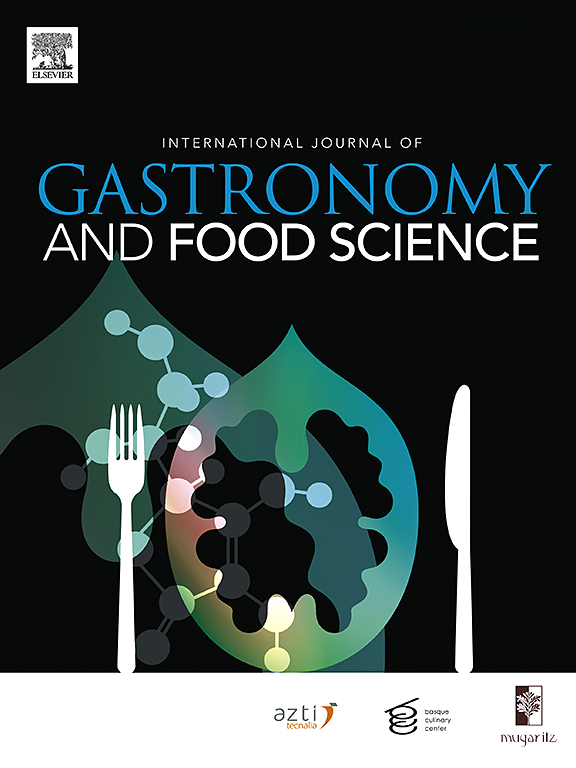Production and characterization of a natural cultural drink - ginger ale
IF 3.2
2区 农林科学
Q2 FOOD SCIENCE & TECHNOLOGY
International Journal of Gastronomy and Food Science
Pub Date : 2025-04-25
DOI:10.1016/j.ijgfs.2025.101188
引用次数: 0
Abstract
Ginger ale is a fermented beverage made of ginger possessing functional and probiotic potential, which makes it a rather attractive and popular non-alcoholic beverage. Given these properties, this study aimed to produce a non-alcoholic fermented beverage based on microorganisms found in ginger by replicating our methodologies found in literature (A, B, C and D), and its physicochemical and microbiological characteristics have been analyzed thereof. It was made based on two stages of fermentation, the former being aerobic to produce the starters (ginger bug) lasting from 4 to 7 days, and the latter anaerobic for producing the resulting beverage (ginger ale), totaling 3 days. After fermentation, physicochemical and microbiological analyses were carried out and samples were stored under refrigeration until the 30th day. Afterwards, it was found that the ginger ale samples produced based on methodologies A and B had the lowest alcohol content (0.44 and 0.39 % v/v, respectively) and the smallest sugar concentrations. On the 15th day, both were still considered non-alcoholic, but they became alcoholic on the 30th day. The ginger ale samples produced through methodologies C and D were alcoholic from the 3rd day of fermentation. Moreover, the samples obtained by the four methodologies had some probiotic cultures, but were nonetheless unable to be characterized as probiotic beverages due to the fact that their total phenolic content was the same throughout fermentation. The sample produced by methodology A, which had the most satisfactory characteristics, was submitted to a sensory analysis, and over 70 % acceptance was found for all attributes being evaluated. Thus, the ginger ale samples produced by this work are quite promising.
一种天然文化饮料——姜汁啤酒的生产与表征
姜汁汽水是一种由生姜发酵而成的饮料,具有功能性和益生菌的潜力,是一种非常有吸引力和受欢迎的非酒精饮料。鉴于这些特性,本研究旨在通过复制文献(a, B, C和D)中发现的方法,以生姜中的微生物为基础生产一种非酒精发酵饮料,并对其理化和微生物特性进行了分析。它是基于两个阶段的发酵,前一个是好氧发酵,产生发酵剂(姜虫),持续4至7天,后一个是厌氧发酵,生产最终的饮料(姜汁啤酒),总共3天。发酵后进行理化和微生物学分析,冷藏保存至30天。之后,发现基于方法A和B生产的姜汁汽水样品具有最低的酒精含量(分别为0.44和0.39% v/v)和最低的糖浓度。在第15天,两个人仍然被认为不酗酒,但在第30天他们变成了酒鬼。通过方法C和D生产的姜汁啤酒样品从发酵第3天开始就具有酒精。此外,通过四种方法获得的样品有一些益生菌培养物,但由于在整个发酵过程中它们的总酚含量相同,因此无法被定性为益生菌饮料。采用方法A生产的样品具有最令人满意的特征,并提交感官分析,所有属性的接受度超过70%。因此,本工作生产的姜汁啤酒样品具有很大的应用前景。
本文章由计算机程序翻译,如有差异,请以英文原文为准。
求助全文
约1分钟内获得全文
求助全文
来源期刊

International Journal of Gastronomy and Food Science
Social Sciences-Cultural Studies
CiteScore
5.30
自引率
10.50%
发文量
170
审稿时长
45 days
期刊介绍:
International Journal of Gastronomy and Food Science is a peer-reviewed journal that explicitly focuses on the interface of food science and gastronomy. Articles focusing only on food science will not be considered. This journal equally encourages both scientists and chefs to publish original scientific papers, review articles and original culinary works. We seek articles with clear evidence of this interaction. From a scientific perspective, this publication aims to become the home for research from the whole community of food science and gastronomy.
IJGFS explores all aspects related to the growing field of the interaction of gastronomy and food science, in areas such as food chemistry, food technology and culinary techniques, food microbiology, genetics, sensory science, neuroscience, psychology, culinary concepts, culinary trends, and gastronomic experience (all the elements that contribute to the appreciation and enjoyment of the meal. Also relevant is research on science-based educational programs in gastronomy, anthropology, gastronomic history and food sociology. All these areas of knowledge are crucial to gastronomy, as they contribute to a better understanding of this broad term and its practical implications for science and society.
 求助内容:
求助内容: 应助结果提醒方式:
应助结果提醒方式:


